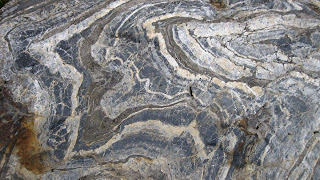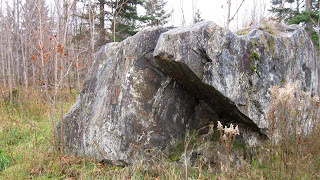During the 1970s museum founder, Axel Niemi, also worked for Burt Township managing the campground Woodland Park. He didn't think he was getting paid enough for all his efforts. That may be true since today there are 9 people doing what Axel did on his own for almost 30 years. Anyway, he convinced the township board that there was a need to advertise Grand Marais as a tourist destination. He received $300 from the board to market the campground.
Axel decided to produce a brochure. On the brochure he described our hamlet community and listed the local sites. One of the attractions listed in the brochure was the "meteor." On the corner downtown there were signs directing tourists to these local sites. At some of the sites, such as at the "meteor," signs were also installed.
At about the same time, Axel also published his book entitled Michigan's Glacial Gemstones of Northeastern Upper Peninsula--a Beginners Guide." Everything in the 30 page 7 1/2 x 6 book was factual and useful, except for one small story:
OBSERVING A FALLING METEORApproximate day of occurences 10 January 1920. Mid-day.
Since a meteor is composed mostly of iron, and the only manner of occurence as iron in the natural state, the mineral or metal tends to oxidize and disappear after a few years. Nevertheless from the description given by the observer, this meteorite could very well be still in its original area of fall.
While walking across Au Sable Lake in Alger County in the winter, Otto N. Niemi observed the object. At first a sound, such as a strong wind would make, was heard. Mr. Niemi, on the open ice, had nowhere to go for shelter. Suddenly he observed a streak in the sky just above treetop level to the south. The object was coming closer and closer, leaving a trail of smoke or vapor. The angle of travel was such as to avoid the lake and traveled to his right hitting a tree top at the south end of the lake. The meteor (while still in air, it is a meteor; on ground it is a meteorite) finally crashed through the tops of some birch trees and into the ground.
Since the time was already beyond half-past the day, with traps and furs in sack, Otto Niemi never did visit the area of the fall, although he insists that it was not far from the edge of the lake. A real attempt to locate this object has never been made. The high pitched sound indicated a meteor flying and producing a rapid spinning motion. This type meteor disintegrates after striking an object. However, the fact that a large limb was taken down fro the birch tree may indicate simply a fast moving object which produced the sound due to the friction against the atmosphere, and not due to spinning motion. If such is the case, then the meteorite may well be buried nearby.
Here are a few shots of the "meteor." The story behind the story is below.





Axel re-printed his agate book three times. The first time, he didn't provide any explanation regarding the "meteor" story. The second time he printed a disclaimer on another page in the book. The third time he printed the disclaimer on the same page. Here is the disclaimer:
The author knows of an area where a meteor had fallen years ago not so far from the rock that is now marked as a "meteor." the large stone marked "meteor" is not a meteorite at all. Rather it is a piece of metamorphic iron sediment (note the layers of formation).
The rock, not including the slab broken off one end, is 21' x 12' x 8'. This is a large metamorphic rock that was most likely formed on the north shore of Lake Superior prior to the time that the North America continent was formed. Around a billion years ago a "baby" craton continent moved northeast and collided with the Superior craton. The force of the collision metamorphized some of the rock on the north shore of what is now Lake Superior. Most likely this large rock broke off, was carried by the glaciers, and later was dumped where it now sits.

No comments:
Post a Comment